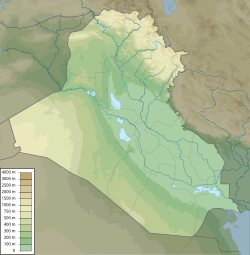Top Qs
Timeline
Chat
Perspective
Al-Askari Shrine
10th-century Shia mosque and mausoleum in Iraq From Wikipedia, the free encyclopedia
Remove ads
The Al-Askari Shrine (Arabic: مَرْقَد ٱلْإِمَامَيْن عَلِيّ ٱلْهَادِي وَٱلْحَسَن ٱلْعَسْكَرِيّ, romanized: Marqad al-ʾImāmayn ʿAlī al-Hādī wal-Ḥasan al-ʿAskarī, lit. 'Resting Place of the Two Imams Ali al-Hadi and Hasan al-Askari'), also known as the 'Askariyya Shrine and the Al-Askari Mosque, is a Twelver Shi'ite mosque and mausoleum, located in the city of Samarra, in the Saladin Governorate of Iraq.
Built in 944 CE,[1] it is one of the most important Shia shrines in the world. The dome was destroyed in a bombing by Sunni extremists in February 2006 and its two remaining minarets were destroyed in another bombing in June 2007, causing widespread anger among Shias and instigation of the Iraqi Civil War between the country's Shia and Sunni factions.[2] The remaining clock tower was also destroyed in July 2007.[3] The dome and minarets were repaired and the mosque reopened in April 2009.[4]
The 10th and 11th Shī'īte Imams, 'Alī al-Hādī ("an-Naqī") and his son Ḥasan al-'Askarī, known as al-'Askariyyayn ("the two 'Askarīs"), are buried in the shrine.[5] Housed in the mosque are also the tombs of Ḥakīma Khātūn, sister of 'Alī al-Hādī; and Narjis Khātūn, the mother of Muḥammad al-Mahdī.[6] Adjacent to the mosque is another domed commemorative building, the Serdab ("cistern"), built over the cistern where the Twelfth Imam, Muḥammad al-Mahdī, first entered the Minor Occultation or "hidden from the view"—whence the other title of the Mahdi, the Hidden Imam.[citation needed]
The mosque is located within the 15,058-hectare (37,210-acre) Samarra Archaeological City UNESCO World Heritage Site, listed in 2007.[7]
Remove ads
History
The Imams 'Alī al-Hādī ("an-Naqī") and Haṣan al-'Askarī lived under house arrest in the part of Samarra that had been Caliph al-Mu'tasim's military camp ('Askar al-Mu‘tasim, hence an inmate of the camp was called an 'Askarī). As a result, they are known as the 'Askariyyayn. They died and were buried in their house on Abī Ahmad Street near the mosque built by Mu'tasim.[6] A later tradition attributes their deaths to poison.[citation needed]
Nasir ad-Din Shah Qajar undertook the latest remodelling of the shrine in 1868, with the golden dome added in 1905. Covered in 72,000 gold pieces and surrounded by walls of light blue tiles, the dome was a dominant feature of the Samarra skyline. It was approximately 20 metres (66 ft) in diameter by 68 metres (223 ft) high.[citation needed]
Remove ads
Bombings
Summarize
Perspective
2006 attack
On 22 February 2006, at 6:55 am local time (03:55 UTC) explosions occurred at the shrine, effectively destroying its golden dome and severely damaging the shrine. Several men belonging to Iraqi insurgent groups affiliated with Al-Qaida, one wearing a military uniform, had earlier entered the mosque, tied up the guards there and set explosives, resulting in the blast. Two bombs were set off[8][9] by five[10] to seven[11] men dressed as personnel of the Iraqi Special Forces[12] who entered the shrine during the morning.[13]
Time magazine reported at the time of the 2006 bombing that:
al-Askari [is] one of Shi'ite Islam's holiest sites, exceeded in veneration only by the shrines of Najaf and Karbala. Even Samarra's Sunnis hold al-Askari in high esteem. The expression 'to swear by the shrine' is routinely used by both communities".[14]
2007 attack
At around 8 am on 13 June 2007, operatives belonging to al-Qaeda in Iraq destroyed the two remaining 36-metre-high (118 ft) golden minarets flanking the dome's ruins. No fatalities were reported. Iraqi police reported hearing "two nearly simultaneous explosions coming from inside the mosque compound at around 8 am".[15] A report from state-run Iraqiya Television stated that "local officials said that two mortar rounds were fired at the two minarets".[15]
Reopening

In late 2007, the Iraqi government conducted a contract with a Turkish company to rebuild the shrine. The Iraqi government later cancelled the contract due to delays by the Turkish company.[4] As of April 2009[update], the golden dome and the minarets were restored and the shrine reopened to visitors.[4]
Remove ads
Notable burials
Among the famous people buried in this place are:[16]
- Imam Ali al-Hadi – the 10th Shia Imam
- Imam Hasan al-Askari – the 11th Shia Imam
- Hakima Khatun – daughter of the 9th Shia Imam
- Narjis – wife of the 11th Shia Imam
- Hussain ibne imam Ali Naqi A.s
Gallery
- The shrine in 1916
- The shrine in 2006 after the first bombing
- Repairs to the mosque, October 2013
- Al-Askari Shrine clock tower
- General view of the shrine
- The shrine at night
See also
References
Further reading
External links
Wikiwand - on
Seamless Wikipedia browsing. On steroids.
Remove ads









